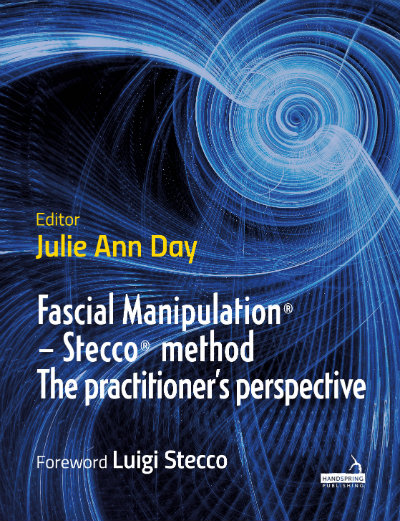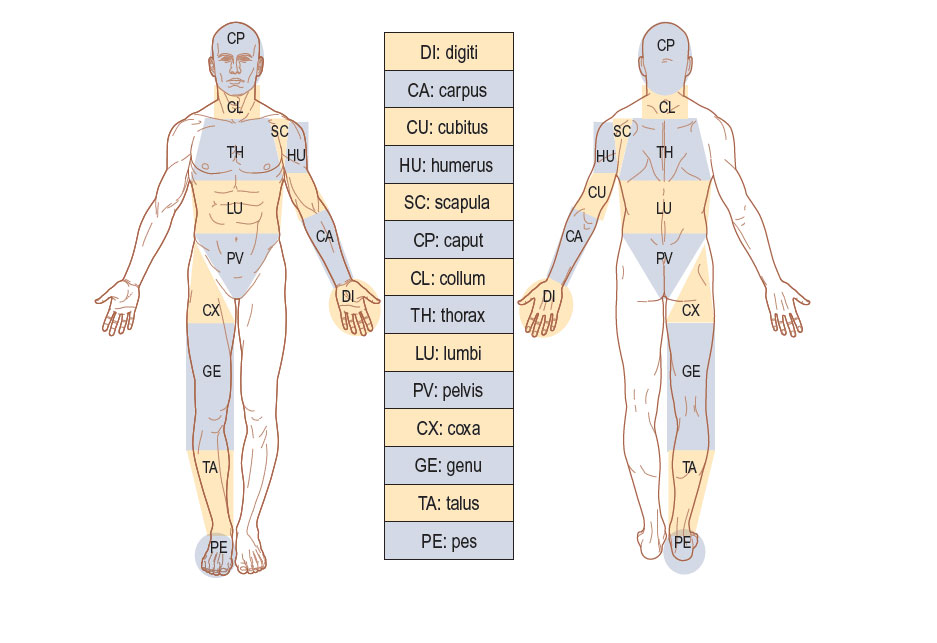Fascial Manipulation® – Stecco® method: The practitioner’s perspective
Fascial Manipulation® – Stecco® method: The practitioner’s perspective, Editor: J A Day Publisher: Handspring publishing, 2018.
Despite the plethora of information that we have access to these days, don’t we still turn to our peers for inspiration and guidance? The immense popularity of Twitter is just one example of how we seek information from others. Clinician’s don’t always have the time to peruse through all of the available literature regarding any given subject but having access to other colleagues’ insights and experience can guide us in new, thought-provoking directions.
As an Australian-trained physiotherapist who moved to Italy many years ago, since 1998 I have had the chance to study with the founder of the Fascial Manipulation® – Stecco® method, Luigi Stecco, who is also a physiotherapist.
The Fascial Manipulation® – Stecco® method is a manual therapy based on biomechanical models that introduce new paradigms for incorporating the fascial system into the interpretation of musculoskeletal and internal dysfunctions. In turn, as these models are based on anatomical studies and dissections that have investigated the complexity of the fascial system they offer an approach that has a solid anatomical rationale. A significant number of professionals have recognised and embraced these models in their clinical work and, in 2017, approximately 2,500 therapists from over 50 countries attended courses addressing this method.
While teaching this method in numerous countries, I have witnessed this growth of interest in the Stecco models, particularly over the last 10 years. During this time, I have encountered a wide range of therapists who have impressed me with their background knowledge, clinical experience and, yes, curiosity. In effect, the opportunity to share the impact that the Fascial Manipulation® – Stecco® method has had on modifying the clinical practice of a selection of these practitioners was the chief catalyst for compiling a new book called ‘Fascial Manipulation® – Stecco® method: The practitioner’s perspective’ (2018). Professionals from different countries, including USA, Canada, Finland, Japan, Israel, Poland and Italy, and different disciplines, such as physiotherapy, osteopathy, chiropractic and massage therapy, have contributed to this book.
The Contributors to this book are: M Branchini, N Brettler, J Ciechomski, L Copetti, L Freschi, W I Hammer, T Lahtinen-Suopanki, A Mackenzie, E Mangel, C Megalos, S F Oswald, A Pasini, L Steinbeck, H Takei, N Tolvanen, C Whiteford.
While there are several texts books by Luigi Stecco that explain in detail the theoretical bases and practical applications of the Fascial Manipulation® – Stecco® method (Stecco 2004, 2009, 2016, 2017), as well as a number of articles regarding clinical research into this method, this new book places emphasis on the value of clinical expertise and clinical judgement skills in such an emerging field.
What struck me most while editing and compiling this book was that this representative group of 16 professionals had no particular need to adopt a completely new paradigm. They were all successful in their careers when they first encountered Stecco’s proposals. While completing and publishing quality clinical research is vitally important, it does not always provide clinicians with practical guidelines that readily assist them in their work. Quite rightly these professionals have approached these new models from an analytical position yet, effectively, it was the clinical results these professionals witnessed by applying the Stecco models that convinced them to explore the method further, integrating it into their work to varying degrees. These colleagues, and many others like them, have inspired me to keep teaching this method, sharing what knowledge of fascial anatomy I have gained over the years and continuing to explore possible clinical applications.
Clinical experience is one of the three cornerstones of the Evidence Based Medicine (EBM) triangle, the other two being the best available literature and patient preferences. Clinicians in all health fields are actively encouraged to cultivate evidence-based practice (EBP) approaches, and professionals have an ethical obligation to inform themselves about current evidence, to update their skills and knowledge and to apply the best available treatment modalities. However, for a number of reasons, professionals are frequently coerced into thinking that published research alone validates any given approach and that the other two cornerstones of EBP impact on their treatment choices to a much lesser degree. Yet we still look to our peers, particularly those who have more experience than us. What they are interested in, the trends they are exploring and their opinions can have great value for all of us.
In this new book, each professional has been asked to present a case study, or a short case series, in which they have applied the Fascial Manipulation® method and to discuss how their understanding of the musculoskeletal system and the role of the fasciae in interactions between the musculoskeletal and internal systems has been modified since encountering this approach.
The book is particularly useful for practitioners who
- are interested in approaching fascial work and would like to know more about the areas where it can be applied
- have already started to explore the models presented by Luigi Stecco by attending some of the courses and simply want to know more by hearing about the experiences of others who are currently applying this method.
So, what’s new in ‘Fascial Manipulation® – Stecco® method: The practitioner’s perspective’?
The introduction presents some historical background to the development of the Fascial Manipulation® – Stecco® method. Some of you may not be aware that Luigi Stecco compared many human anatomy textbooks with the diversity of vertebrate and invertebrate anatomy from the animal world, along with texts concerning acupuncture and myofascial trigger points, before developing models that focus on the role of fascial tissue in 1) musculoskeletal and 2) internal dysfunctions.
Through his anatomical studies, Stecco realised that fascia is structured in a way that is suited to coordinating and perceiving the movements of the human body. According to the various anatomical layers of fascia, he divides the fascial system into 14 functional segments.
Fourteen functional segments composed of parts of muscles, one or more related joints and their fascial surround. Latin terms are used to describe these segments (Illustration copyright Handspring publishing, reproduced here with kind permission from Handspring publishing).
Each segment is governed by myofascial units that make up myofascial sequences, diagonals and spirals for musculoskeletal dysfunctions; tensile structures and catenaries for internal organ and apparatus dysfunctions and quadrants for superficial fascia dysfunctions. Stecco has identified and mapped key areas in these fascial structures where lack of sliding between fascial layers can apparently alter proprioception, muscle recruitment and internal functions, leading to symptoms of non-specific pain or myofascial pain. Therapists use his models to identify alterations in these key areas and then apply either deep friction or more superficial techniques to restore inter-fascial gliding.
The fascial system is a very complex, three-dimensional and multi-layered network. Simplified models are essential because they provide a sort of GPS we can follow to understand how tensional compensations spread throughout the body, where to act to resolve these tensions and, perhaps most of all, how to backtrack and re-think about our hypotheses whenever our manual therapy does not give the desired outcome.
In the Introduction to this new book, you will find an outline of the two Stecco models and the assessment process used in the Fascial Manipulation® – Stecco® method, and readers can refer to these outlines to follow the clinical reasoning used in the case reports presented in each chapter. Those who are interested in exploring these models further can consult the more detailed texts by Stecco.
Chapters have been divided into three main sections:
- Musculoskeletal dysfunctions: in this section you will find case reports dealing with the application of the Fascial Manipulation® – Stecco® method in cases of low back pain, TMJ dysfunction, chronic ankle instability, severe sciatic-type pain in an elderly patient and runner’s knee pain, as well as several cases dealing with extended pain patterns.
- Internal dysfunctions: here you can read about the treatment of chronic neck pain, thoracic outlet syndrome, chronic polyuria, Bell’s palsy sequels, post-partum urinary incontinence, the resolution of partial nipple necrosis and bilateral calcaneal pain. Some of these cases sound like they could have a musculoskeletal origin but symptoms were addressed by following Stecco’s model for internal dysfunctions.
- Other perspectives: this section presents a case series report on postural changes after treatment, some new proposals for Fascial Manipulation® – Stecco® method practitioners to consider and observations from a physiotherapist who applies this method in neurological paediatric cases.
The concept of this book is to give voice to clinicians who in some ways have been pioneers in exploring a new paradigm for musculoskeletal and internal dysfunctions. Not all clinicians are in a position to carry out scientific studies, so their opinions and experiences often remain unheard. I hope you will find their reports as interesting as I do.
Fascial Manipulation® – Stecco® method: The practitioner’s perspective is available at www.terrarosa.com.au
References:
Day J A (Editor) Fascial Manipulation® – Stecco® method: The practitioner’s perspective (2018) Edinburgh: Handspring publishing.
Stecco L. (2004) Fascial Manipulation for Musculoskeletal Pain. Padova: Piccin.
Stecco L. (2016) Atlas of Physiology of the Muscular Fascia. Padova: Piccin.
Stecco L, Stecco A. (2016) Fascial Manipulation for Internal Dysfunctions-Practical Part. Padova: Piccin.
Stecco L, Stecco C. (2009) Fascial Manipulation: Practical Part. Padova: Piccin.
Stecco L, Stecco C. (2014) Fascial Manipulation for Internal Dysfunctions. Padova: Piccin.



